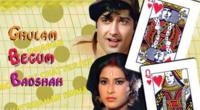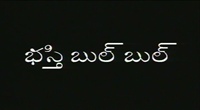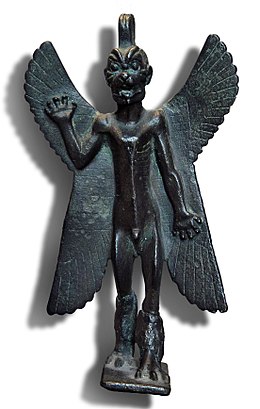A demon is a supernatural and often malevolent being prevalent in religion, occultism, literature, fiction, mythology and folklore.
The original Greek word daimon does not carry negative connotations. The Ancient Greek word ?????? daim?n denotes a spirit or divine power, much like the Latin genius or numen. The Greek conception of a daim?n notably appears in the works of Plato, where it describes the divine inspiration of Socrates.
In Ancient Near Eastern religions and in the Abrahamic traditions, including ancient and medieval Christian demonology, a demon is considered a harmful spiritual entity which may cause demonic possession, calling for an exorcism. In Western occultism and Renaissance magic, which grew out of an amalgamation of Greco-Roman magic, Jewish Aggadah and Christian demonology, a demon is believed to be a spiritual entity that may be conjured and controlled.
Screenplay
The Ancient Greek word ?????? daim?n denotes a spirit or divine power, much like the Latin genius or numen. Daim?n most likely came from the Greek verb daiesthai (to divide, distribute). The Greek conception of a daim?n notably appears in the works of Plato, where it describes the divine inspiration of Socrates. To distinguish the classical Greek concept from its later Christian interpretation, the former is anglicized as either daemon or daimon rather than demon. The original Greek word daimon does not carry the negative connotation initially understood by implementation of the Koine ????????? (daimonion), and later ascribed to any cognate words sharing the root.
The Greek terms do not have any connotations of evil or malevolence. In fact, ?????????? eudaimonia, (literally good-spiritedness) means happiness. By the early Roman Empire, cult statues were seen, by pagans and their Christian neighbors alike, as inhabited by the numinous presence of the gods: "Like pagans, Christians still sensed and saw the gods and their power, and as something, they had to assume, lay behind it, by an easy traditional shift of opinion they turned these pagan daimones into malevolent 'demons', the troupe of Satan..... Far into the Byzantine period Christians eyed their cities' old pagan statuary as a seat of the demons' presence. It was no longer beautiful, it was infested." The term had first acquired its negative connotations in the Septuagint translation of the Hebrew Bible into Greek, which drew on the mythology of ancient Semitic religions. This was then inherited by the Koine text of the New Testament. The Western medieval and neo-medieval conception of a demon derives seamlessly from the ambient popular culture of Late Antiquity. The Hellenistic "daemon" eventually came to include many Semitic and Near Eastern gods as evaluated by Christianity.
The supposed existence of demons remains an important concept in many modern religions and occultist traditions. Demons are still feared largely due to their alleged power to possess living creatures. In the contemporary Western occultist tradition (perhaps epitomized by the work of Aleister Crowley), a demon (such as Choronzon, which is Crowley's interpretation of the so-called 'Demon of the Abyss') is a useful metaphor for certain inner psychological processes (inner demons), though some may also regard it as an objectively real phenomenon. Some scholars believe that large portions of the demonology (see Asmodai) of Judaism, a key influence on Christianity and Islam, originated from a later form of Zoroastrianism, and were transferred to Judaism during the Persian era.
Egypt
Both deities and demons can act as intermediaries to deliver messages to humans. Thus they share some resemblance to the Greek daimonion. The exact definition of "demon" in Egyptology posed a major problem for modern scholarship, since the borders between a deity and a demon are sometimes blurred and the ancient Egyptian language lacks a term for the modern English "demon". However, magical writings indicate that ancient Egyptians acknowledged the existence of malevolent demons by highlighting the demon names with red ink. Demons in this culture appeared to be subordinative and related to a specific deity, yet they may have occasionally acted independent from the divine will. The existence of demons can be related to the realm of chaos, beyond the created world. But even this negative connotation cannot be denied in light of the magical texts. The role of demons in relation to the human world remains ambivalent and largely depends on context.
Ancient Egyptian demons can be divided into two classes: "guardians" and "wanderers." "Guardians" are tied to a specific place; their demonic activity is topographically defined and their function can be benevolent towards those who have the secret knowledge to face them. Demons protecting the underworld may prevent human souls from entering paradise. Only by knowing right charms is the deceased able to enter the Halls of Osiris. Here, the aggressive nature of the guardian demons is motivated by the need to protect their abodes and not by their evil essence. Accordingly, demons guarded sacred places or the gates to the netherworld. During the Ptolemaic and Roman period, the guardians shifted towards the role of Genius loci and they were the focus of local and private cults.
The "wanderers" are associated with possession, mental illness, death and plagues. Many of them serve as executioners for the major deities, such as Ra or Osiris, when ordered to punish humans on earth or in the netherworld. Wanderers can also be agents of chaos, arising from the world beyond creation to bring about misfortune and suffering without any divine instructions, led only by evil motivations. The influences of the wanderers an be warded off and kept at the borders on the human world by the use of magic, but they can never be destroyed. A sub-category of "wanderers" are nightmare demons, which were believed to cause nightmares by entering a human body.
Mesopotamia
According to the Jewish Encyclopedia, "In Chaldean mythology the seven evil deities were known as shedu, storm-demons, represented in ox-like form." They were represented as winged bulls, derived from the colossal bulls used as protective jinn of royal palaces.
From Chaldea, the term shedu traveled to the Israelites. The writers of the Tanach applied the word as a dialogism to Canaanite deities.
There are indications that demons in popular Hebrew mythology were believed to come from the nether world. Various diseases and ailments were ascribed to them, particularly those affecting the brain and those of internal nature. Examples include catalepsy, headache, epilepsy and nightmares. There also existed a demon of blindness, "Shabriri" (lit. "dazzling glare") who rested on uncovered water at night and blinded those who drank from it.
Demons supposedly entered the body and caused the disease while overwhelming or "seizing" the victim. To cure such diseases, it was necessary to draw out the evil demons by certain incantations and talismanic performances, at which the Essenes excelled. Josephus, who spoke of demons as "spirits of the wicked which enter into men that are alive and kill them", but which could be driven out by a certain root, witnessed such a performance in the presence of the Emperor Vespasian and ascribed its origin to King Solomon. In mythology, there were few defences against Babylonian demons. The mythical mace Sharur had the power to slay demons such as Asag, a legendary gallu or edimmu of hideous strength.
As referring to the existence or non-existence of demons (shedim or Se'irim) there are converse opinions in Judaism. There are "practically nil" roles assigned to demons in the Hebrew Bible. In Judaism today, beliefs in "demons" or "evil spirits" are either midot hasidut (Hebr. for "customs of the pious"), and therefore not halachah, or notions based on a superstition that are non-essential, non-binding parts of Judaism, and therefore not normative Jewish practice. In conclusion, Jews are not obligated to believe in the existence of shedim, as posek rabbi David Bar-Hayim points out.
Tanach
The Tanakh mentions two classes of demonic spirits, the se'irim and the shedim. The word shedim appears only in two places in the Tanakh (Psalm 106:37, Deuteronomy 32:17). The se'irim are mentioned once in Leviticus 17:7, probably a re-calling of Assyrian demons in shape of goats. The shedim in return are not pagan demigods, but the foreign gods themselves. Both entities appear in a scriptural context of animal or child sacrifice to "non-existent" false gods.
Talmudic tradition
In the Jerusalem Talmud notions of shedim ("demons" or "spirits") are almost unknown or occur only very rarely, whereas in the Babylon Talmud there are many references to shedim and magical incantations. The existence of shedim in general was not questioned by most of the Babylonian Talmudists. As a consequence of the rise of influence of the Babylonian Talmud over that of the Jerusalem Talmud, late rabbis in general took as fact the existence of shedim, nor did most of the medieval thinkers question their reality. However, rationalists like Maimonides, Saadia Gaon and Abraham ibn Ezra and others explicitly denied their existence, and completely rejected concepts of demons, evil spirits, negative spiritual influences, attaching and possessing spirits. Their point of view eventually became mainstream Jewish understanding.
Kabbalah
In Kabbalah demons are regarded a necessary part of the divine emanation in the material world and a byproduct of human sin (Qliphoth). However spirits such as the shedim may also be benevolent and were used in kabbalistic ceremonies (as with the golem of Rabbi Yehuda Loevy) and malevolent shedim (mazikin, from the root meaning "to damage") were often credited with possession.
Aggadah
Aggadic tales from the Persian tradition describe the shedim, the mazzi?im ("harmers"), and the ru?in ("spirits"). There were also lilin ("night s
Watch movie Demons online on Amazon
Watch movie Demons online
Watch The Movie On PrimeHumdum (2005) Full HD Movie Download
.jpg)
Gulam Begum Badshah Full HD Movie Download

Raja Jani Full HD Movie Download

Hum Full HD Movie Download

Anarkali (1953) Full HD Movie Download
.jpg)
Rakshak: The Protector Full HD Movie Download

Satyameba Jayate Full HD Movie Download

Porki Full HD Movie Download

Agni Satchi Full HD Movie Download

Sachhai Ki Taaqat (2005) Full HD Movie Download
.jpg)
Embryo Full HD Movie Download

Don Seenu Full HD Movie Download

Dil Full HD Movie Download

Kanulu Musina Nuvve Full HD Movie Download

Kiladi Bullodu Full HD Movie Download

Basthi Bul Bul Full HD Movie Download

Japanil Kalyanaraman Full HD Movie Download

Debdas (Bengali) Full HD Movie Download
.jpg)
Naughty Boy Full HD Movie Download

Rocket Singh: Salesman of the Year Full HD Movie Download

Aurangzeb (2013) Full HD Movie Download
.jpg)
Download latest Movie from bollywood
- 1> baaghi 3
- 2> THE SKY IS PINK MOVIE FULL STORY AND REVIEW
- 3> Luka Chuppi
- 4> TO ALL THE BOYS I’VE LOVED BEFORE
- 5> Kabir Singh
- 6> Street Dancer 3D
- 7> Simmba
- 8> Gone Girl
- 9> The Girl Who Lived
- 10> Ludo
- 11> DILWALE DULHANIA LE JAYENGE
- 12> GUILTY
- 13> The Godfather
- 14> Adventures of Rusty
- 15> Sooryavanshi
- 16> Satyameva Jayate 2
- 17> Thappad
- 18> Bhool Bhulaiyaa 2
- 19> KGFChapter 2
- 20> Mardaani 2
- 21> Pinjar
- 22> Shivaji maharaj
- 23> Ek Villian 2
- 24> Hungama 2
- 25> Divergent
- 26> Mumbai Saga
- 27> The Internship
- 28> HIT (telugu)
- 29> Panga
- 30> The perfect date
- 31> 16 December
- 32> Gopala Gopala (Telugu)
- 33> Brahmastra
- 34> Gangubai Kathiawadi
- 35> Manmadhudu
- 36> Nenu local
- 37> Mahanati
- 38> Shatamanam bavathi
- 39> Lagaan
- 40> After
- 41> MOM
- 42> Shamshera
- 43> Raguvaran BTech
- 44> Khakee
- 45> The villain
- 46> OM
- 47> Mr. perfect
- 48> Bueatifull mind
- 49> Hichki
- 50> Gabbar Singh
- 51> Jogi
- 52> Before Sunrise
- 53> Before Sunset
- 54> Before Midnight
- 55> The Big Bull
- 56> Top Gun: Maverick
- 57> The Purge
- 58> The Sky is Pink
- 59> Laxmmi Bomb
- 60> Sadak 2
- 61> Sufna
- 62> Prithviraj
- 63> PK
- 64> Coolie No 1(2020)
- 65> Black Widow
- 66> Dear Zindagi
- 67> Dil Bechara
- 68> PHIR HERA PHERI
- 69> WAR
- 70> Dostana
- 71> RRR: Roudram Ranam Rudhiram
- 72> Maidan
- 73> Dabbang 3
- 74> Chhalaang
- 75> life as we know it
- 76> SherShaah
- 77> Sandeep Aur Pinky Faraar
- 78> Event Horizon
- 79> 83
- 80> Radhe: Your Most Wanted Bhai
- 81> Gunjan Saxena: The Kargil Girl
- 82> Mr India
- 83> Vivah
- 84> Anokha Bandhan
- 85> Ghost
- 86> Bhoot: Part One - The Haunted Ship
- 87> Haseen Dilruba
- 88> Laal Singh Chaddha
- 89> Qismat
- 90> Rajput
- 91> Drive
- 92> Dil Chahta Hai
- 93> Dil Ki Baazi
- 94> Dil Ka Rishta
- 95> Teesri Manzil
- 96> Dil
- 97> Love Aaj Kal
- 98> Khaali Peeli
- 99> Bunty Aur Babli 2
- 100> Atrangi Re
- 101> Gulabo Sitabo
- 102> Jodi
- 103> Suraj Pe Mangal Bhari
- 104> Deewana
- 105> Attack
- 106> Sardar Udham Singh
- 107> Toofan
- 108> THE LOVEBIRDS
- 109> Jersey
- 110> Ginny Weds Sunny
- 111> Thalaivi
- 112> Shiddat
- 113> Angels vs Zombies
- 114> Koi Mil Gya
- 115> Thank God
- 116> Bhuj: The Pride of India
- 117> Hum Aapke Hain Kaun
- 118> The Platform
- 119> Bird Box
- 120> Roohi Afzana
- 121> Torbaaz
- 122> Nikamma
- 123> World War Z
- 124> Extraction
- 125> Train to Busan
- 126> Life of Pi
- 127> SHAADI MEIN JROOR AANA
- 128> Himmat Aur Mehnat
- 129> To All The Boys: P.S. I Still Love You
- 130> Mimi
- 131> Good Newwz
- 132> Shubh Mangal Zyada Saavdhan
- 133> Raabta
- 134> Harry Potter and the Philosopher's Stone
- 135> Harry Potter and the Chamber of Secrets
- 136> Chhapaak
- 137> War of the Worlds
- 138> Harry Potter and the Prisoner of Azkaban
- 139> Harry Potter and the Goblet of Fire
- 140> MURDER MYSTERY
- 141> Shakuntala Devi
- 142> Bachchan Pandey
- 143> Jayeshbhai Jordar
- 144> Sheer Qorma
- 145> Saina
- 146> 'O' Pushpa I hate tears
- 147> Kedarnath
- 148> MS Dhoni The Untold Story
- 149> Chhichhore
- 150> Badhaai Ho
- 151> Unstoppable
- 152> Oz the Great And Powerful
- 153> The Girl on the Train
- 154> Haathi Mere Saathi 2020
- 155> The Conjuring: The Devil Made Me Do It
- 156> Gandhi Se Pehle Gandhi
- 157> The Song of Scorpions
- 158> Srimanthudu
- 159> Hello Guru Prema Kosame
- 160> Beauty and The Beast
- 161> Black Panther
- 162> Charlie and the Chocolate Factory
- 163> Bole Chudiyan
- 164> Fidaa
- 165> Duvvada Jagannadham
- 166> Bruce Lee: The Fighter
- 167> Hyper
- 168> Yaara
- 169> Red (2020)
- 170> Shivam
- 171> That Is Mahalakshmi
- 172> Nishabdham
- 173> Aashram 2020 web series
- 174> Laxmii
- 175> Mismatched
- 176> STUDENT OF THE YEAR 2
- 177> NAIL POLISH
- 178> Ramprasad Ki Tehrvi
- 179> KAAGAZ
- 180> 12 o Clock
- 181> The Power
- 182> bolo hau
- 183> Tribhanga
- 184> JAMUN
- 185> Madam Chief Minister
- 186> Maasaab
- 187> Aadhaar
- 188> Tanhaji
- 189> Bhaagi 3
- 190> Bhootnath
- 191> MALANG
- 192> Jai Mummy Di
- 193> Haathi Mere Saathi 2021
- 194> Shakeela
- 195> Unpaused
- 196> Annayya
- 197> Vamsoddharakudu
- 198> Mrugaraju
- 199> Narasimha Naidu
- 200> Sankranti
- 201> Manasu Maata Vinadhu
- 202> Anjaane
- 203> Apaharan
- 204> Bachke Rehna Re Baba
- 205> Bewafaa
- 206> Roohi
- 207> Radhe
- 208> Zindagi Khoobsoorat Hai
- 209> Yeh Mohabbat Hai
- 210> Yeh Kya Ho Raha Hai?
- 211> The Tomorrow War
- 212> DehradunDiary
- 213> Meri Shaadi Karaoo
- 214> Matruu Ki Bijlee Ka Mandola
- 215> No One Killed Jesica
- 216> Aag Ka Goola
- 217> Eight Million Dollars
- 218> Three Hundred
- 219> Cats and Dog
- 220> Decoy
- 221> Gold Rush
- 222> You Have Got Mail
- 223> Final Destination three
- 224> Tofan
- 225> Jungle
 Story of movie Demons :
Story of movie Demons : 